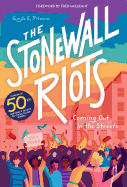
"The reality is that no one remembers exactly what happened that night. And because most newspapers didn't cover the events, and most journalists didn't interview people who participated, we have very few documented accounts of the Stonewall raid and rebellion." The night to which Gayle E. Pitman refers is June 28, 1969, one of many evenings the New York City police raided the Stonewall Inn in Greenwich Village. A small, ramshackle club that got its start as a livery stable, the Stonewall Inn was purchased by mobster Tony Lauria (aka Fat Tony) in 1966. "Fat Tony did a cheap renovation on the property, and a year later he reopened the Stonewall Inn as a gay bar." The June 28 raid ignited a rebellion that is in large part responsible for the modern-day LGBTQ+ movement.
Constructing the book like a museum, Pitman cleverly tells the story of the raid and subsequent riots through a series of objects and mini-biographies. Young readers navigate through the carefully curated pieces of history, which, as Pitman explains, create a different kind of reading experience: "telling a story through objects is like viewing something through a kaleidoscope. Each fragment seems entirely separate, but together they form a colorful, multifaceted image." The fragments of this image include news articles, picket signs and photographs, as well as an arrest record and Dorothy's dress from The Wizard of Oz.
The Stonewall Riots is fascinating, and Pitman's well-informed choices of objects to reconstruct this piece of history are captivating. Additionally, showing Stonewall's ties to current activism offers a close connection for middle-grade audiences. With meaningful content delivered in an innovative format, The Stonewall Riots deserves to be required reading for people of all ages. --Jen Forbus, freelancer

